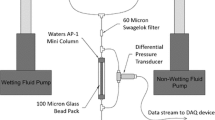Abstract
Recent experimental work has shown that the pore-scale flow mechanism during steady-state two-phase flow in porous media is ganglion dynamics (GD) over a broad and practically significant range of the system parameters. This observation suggests that our conception and theoretical treatment of fractional flow in porous media need careful reconsideration. Here is proposed a mechanistic model of steady-state two-phase flow in those cases where the dominant flow regime is ganglion dynamics. The approach is based on the ganglion population balance equations in combination with a microflow network simulator. The fundamental information on the cooperative flow behavior of the two fluids at the scale of a few hundred pores is expressed through the system factors, which are functions of the system parameters and are calculated using the simulator. These system factors are utilized by the population balance equations to predict the macroscopic behavior of the process. The dependence of the conventional relative permeability coefficients not only on the wetting fluid saturation Swbut also on the capillary number, Ca, the viscosity ratio κ the wettability (θ0 a, θ0 r), the coalescence factor, Co, as well as the porous medium geometry and topology is explained and predicted on a mechanistic basis. Sample calculations have been performed for steady-state fully developed (SSFD) and steady-state nonfully developed (SSnonFD) flow conditions. The number distributions of the moving and the stranded ganglia, the mean ganglion size, the fraction of the nonwetting fluid in the form of mobile ganglia, the ratio of the conventional relative permeability coefficients and the fractional flows are studied as functions of the system parameters and are correlated with the flow phenomena at pore level and the system factors.
Similar content being viewed by others
References
Avraam, D. G., Kolonis, G. B., Roumeliotis, T. C., Constantinides, G. N. and Payatakes, A. C.: 1994, Steady-state two-phase flow through planar and nonplanar model porous media, Transport in Porous Media 16, 75-101.
Avraam, D. G. and Payatakes, A. C.: 1995a, Flow regimes and relative permeabilities during steady-state two-phase flow in porous media, J. Fluid Mech. 293, 207-236.
Avraam, D. G. and Payatakes, A. C.: 1995b, Generalized relative permeability coefficients during steady-state two-phase flow in porous media and correlation with the flow mechanisms, Transport in Porous Media 20, 135-168.
Celia, M. A., Reeves, P. C. and Ferrand, L. A.: 1995, Recent advances in pore scale models for multiphase flow in porous media. U.S. National Report to IUGG, 1991–1994, Rev. Geophys. 33,Suppl. (available at www.earth.agu.org/revgeophys/celia01/celia01.html).
Constantinides, G. N. and Payatakes, A. C.: 1989, A three-dimensional network model for consolidated porous media, Basic studies, Chem. Eng. Comm. 81, 55-81.
Constantinides, G. N. and Payatakes, A. C.: 1991, A theoretical model of collision and coalescence of ganglia in porous media, J. Colloid Interface Sci. 141, 486-504.
Constantinides, G. N. and Payatakes, A. C.: 1996, Network simulation of steady-state two-phase flow in consolidated porous media, AIChE J. 42, 369-382.
Craig, F. F.: 1971, The Reservoir Engineering Aspects of Waterflooding, Soc. Petrol. Eng. AIME, New York.
Dias, M. M. and Payatakes, A. C.: 1986a, Network models for two-phase flow in porous media. Part 1. Immiscible Microdisplacement of non-wetting fluids, J. Fluid Mech. 164, 305-336.
Dias, M. M. and Payatakes, A. C.: 1986b, Network models for two-phase flow in porous media. Part 2. Motion of oil ganglia, J. Fluid Mech. 164, 337-358.
Dullien, F. A. L. and Dhawan, G. K.: 1975, Bivariate pore-size distribution of some sandstones, J. Colloid Interface Sci. 52, 129-135.
Dullien, F. A. L.: 1979, Porous Media. Fluid Transport and Pore Structure, Academic Press, New York.
Gray, W. G. and Hassanizadeh, S. M.: 1991a, Paradoxes and realities in unsaturated flow theory, Water Resour. Res. 27, 1847-1854.
Gray, W. G. and Hassanizadeh, S. M.: 1991b, Unsaturated flow theory including interfacial phenomena, Water Resour. Res. 27, 1855-1863.
Hassanizadeh, S. M. and Gray, W. G.: 1991, Mechanics and thermodynamics of multiphase flow in porous media including interface boundaries, Adv. Water Resour. 13, 169-186.
Hassanizadeh, S. M. and Gray, W. G.: 1993a, Thermodynamic basis of capillary pressure in porous media, Water Resour. Res. 29, 3389-3405.
Hassanizadeh, S. M. and Gray, W. G.: 1993b, Toward an improved description of the physics of two-phase flow, Adv. Water Resour. 16, 53-68.
Hinkley, R. E., Dias, M. M. and Payatakes, A. C.: 1987, On the motion of oil ganglia in porous media, Physico-Chem. Hydrodyn. 8, 185-211.
Honarpour, M. and Mahmood, S. M.: 1988, Relative-permeability measurements: An overview, J. Petrol. Technol. 963-966.
Moré, J., Burton, G. and Hillstrom, K.: 1980, User guide for MINPACK-1. Argonne National Labs, Report ANL-80-74, Argonne, Illinois.
Ng, K. M. and Payatakes, A. C.: 1980, Stochastic simulation of the motion, breakup and stranding of oil ganglia in water-wet granular porous media during immiscible displacement, AIChE J. 26, 419-429.
Payatakes, A. C.: 1982, Dynamics of oil ganglia during immiscible displacement in water-wet porous media, Ann. Rev. Fluid Mech. 14, 365-393.
Payatakes, A. C. and Dias, M. M.: 1984, Immiscible microdisplacement and ganglion dynamics in porous media, Rev. Chem. Eng. 2, 85-174.
Payatakes, A. C., Ng, K. M. and Flummerfelt, R. W.: 1980, Oil ganglion dynamics during immiscible displacement: Model formulation, AIChE J. 26, 430-443.
Press, W. H., Teukolsky, S. A., Vetterling, W. T. and Flannery, B. P.: 1992, Numerical Recipes in FORTRAN. The Art of Scientific Computing, 2nd edn, Cambridge University Press.
Richards, L. A.: 1931, Capillary conduction of liquids through porous mediums, Physics 1, 318-333.
Sastry, V. S. K. and Gaschignard, P.: 1981, Discretization procedure for the coalescence equation of particulate processes, Ind. Eng. Chem. Fundam. 20, 355-361.
Valavanides, M. S., Constantinides, G. N. and Payatakes, A. C.: 1996, Simulation of the motion of oil ganglia in consolidated porous media. Crowding effects, Proc. European Conference on the Mathematics of Oil Recovery V. Leoben, Austria, 3–6 Sept.
Author information
Authors and Affiliations
Rights and permissions
About this article
Cite this article
Valavanides, M.S., Constantinides, G.N. & Payatakes, A.C. Mechanistic Model of Steady-State Two-Phase Flow in Porous Media Based on Ganglion Dynamics. Transport in Porous Media 30, 267–299 (1998). https://doi.org/10.1023/A:1006558121674
Issue Date:
DOI: https://doi.org/10.1023/A:1006558121674




